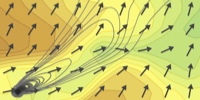
- Overview
- Atmospheric dispersion
- Atmospheric chemistry
- Urban air quality
- Regional to local air quality modelling
- Vehicles and roads
- Aviation
- Emissions
- Urban heat island
- Atmospheric boundary layer
- Wind energy
- Hazardous releases
- Inverse dispersion modelling
- Net Zero
- Model evaluation
- Smart cities
- Web platforms
- Older projects
- CERC co-author publications
- CERC software publications
- Presentations
Net Zero
Quick links: Carbon Capture and Storage modelling Verification of CO2 emissions Cold plumes
CERC has been involved in a wide variety of projects related to Net Zero policies, including
- Assessing issues related to carbon capture and storage, including modelling the dispersion of amine emissions and their associated degradation products, and modelling the controlled venting of CO2;
- Verification of CO2 emissions in urban areas using inverse modelling techniques;
- Modelling the impact of plumes of cold air emitted by heat pumps;
- Quantification of fugitive emissions of methane from sources such as landfill sites, anaerobic digestion facilities, wastewater treatment facilities and onshore oil and gas;
- Modelling the venting of ammonia;
- Assessing a variety of impacts of anaerobic digestion, for example flaring, venting emissions and odour;
- Modelling the emergency venting of refrigerants; and
- Modelling the effects of wind turbines on plume dispersion.
Carbon Capture and Storage modelling
Amines, used in carbon capture processes, can react with other species in the exhaust gas and the atmosphere to produce degradation products (nitrosamines, nitramines) that are potentially harmful. CERC has been involved in amine chemistry dispersion modelling for carbon capture since 2010.
In 2010, CERC participated in the large, interdisciplinary CO2 capture Mongstad (CCM) project:
- Major venture overseen by Statoil Petroleum AS (now Equinor) and Gassnova SF (the Norwegian State enterprise for carbon capture and storage)
- The aim was to improve the understanding and quantification of the dispersion of degradation products of amines in the atmosphere
- CERC demonstrated the feasibility of an amine chemistry module for ADMS
In 2011, CERC was commissioned by CCM Project to carry out this development of the ADMS amine chemistry model code:
- Amine chemistry code based on reaction scheme from: Nielson et al. "Atmospheric Degradation of Amines (ADA). Summary Report: Photo-oxidation of Methylamine, Dimethylamine and Trimethylamine". Climit project no. 201604. Norwegian Institute for Air Research. January, 2011
- Included case studies of dispersion modelling of the amines and their degradation products in the atmosphere, to determine their impact on air quality.
- A summary report from the project can be found here, and more details of the amine chemistry modelling can be accessed here.
In 2012, the amine chemistry scheme was made officially available in ADMS.
More recently, in 2022, CERC further developed the ADMS amine chemistry scheme to allow for multiple sources, multiple amine species and uptake of amines into the aqueous phase. This development was carried out as part of the SCOPE project (Sustainable OPEration of post-combustion Capture plants).
In 2023, these amendments to the amine chemistry scheme were made officially available in ADMS.
The Environment Agency in England commissioned CERC to carry out a project entitled Improving Post-Combustion Carbon Capture Air Quality Risk Assessment Techniques. The main focus was ADMS use in the assessment of amines and their atmospheric degradation products.
The project addressed the uncertainties of input data and assumptions, and improves the transparency and significance of the risk assessment process. It will further increase confidence and understanding of the ADMS approach and assessment strategies.
As part of the project, CERC developed a framework for risk assessments with ADMS. This included the development of an additional user-friendly tool and user guide to help model users calculate and document the amine-related input parameters.
The summary report for the project, produced in 2024, is available here.
Verification of CO2 emissions
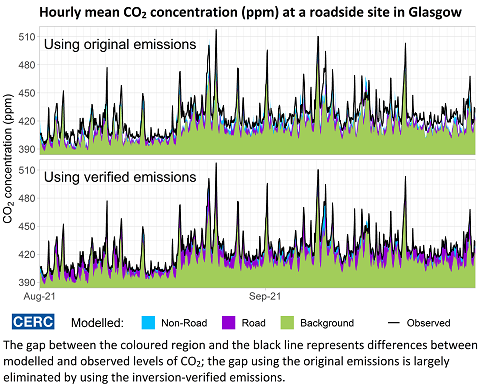
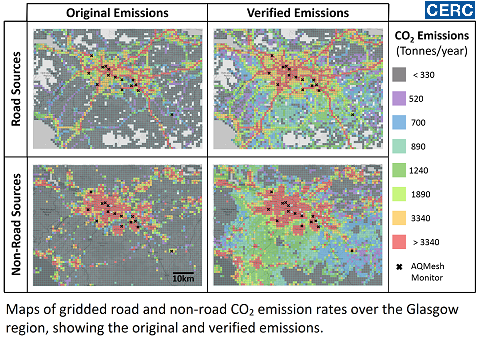
Verification of CO2 emissions is essential to achieving Net Zero and “keeping 1.5 alive”. Researchers from CERC, Cambridge University, and ACOEM collaborated to verify CO2 emissions in Glasgow by combining measurements and ADMS-Urban model output. The study, using available traffic data and emissions factors, suggested that CO2 emissions from road traffic around Glasgow could be underestimated by up to 20%. These methods could be applied to verify the effectiveness of Net Zero policies.
15 AQMesh pods were co-located with Scottish Air Quality Network reference monitors at a number of sites, taking measurements of CO2 and other pollutants at 1-minute resolution. In addition, two LI-COR reference-grade instruments measured CO2 at 1-minute resolution. ADMS-Urban was applied to calculate hourly CO2 concentrations at the measurement sites for the period of the measurements using NAEI gridded emissions and DfT traffic flows, and allowing for the effects of street canyons. Road emissions within 2km of each monitoring site were modelled explicitly as road sources; other road emissions were modelled as 1km x 1km gridded emissions. Hourly background CO2 was obtained from hourly baselines of the 1-minute AQMesh measurements calculated by the University of Cambridge team.
CERC applied Bayesian based inversion techniques to combine hourly modelled CO2 concentrations with hourly AQMesh and LI-COR measurements. The technique allows for the differences in uncertainty between the low-cost sensors and the reference monitors, for the uncertainties of the emissions from each source and for correlations between source emissions. The differences between the original and inversion-verified emissions provide an indication of the accuracy of the original emissions inventory.
The project was funded by NERC and the Scottish Government.
Modelling the temperature impact of cold plumes
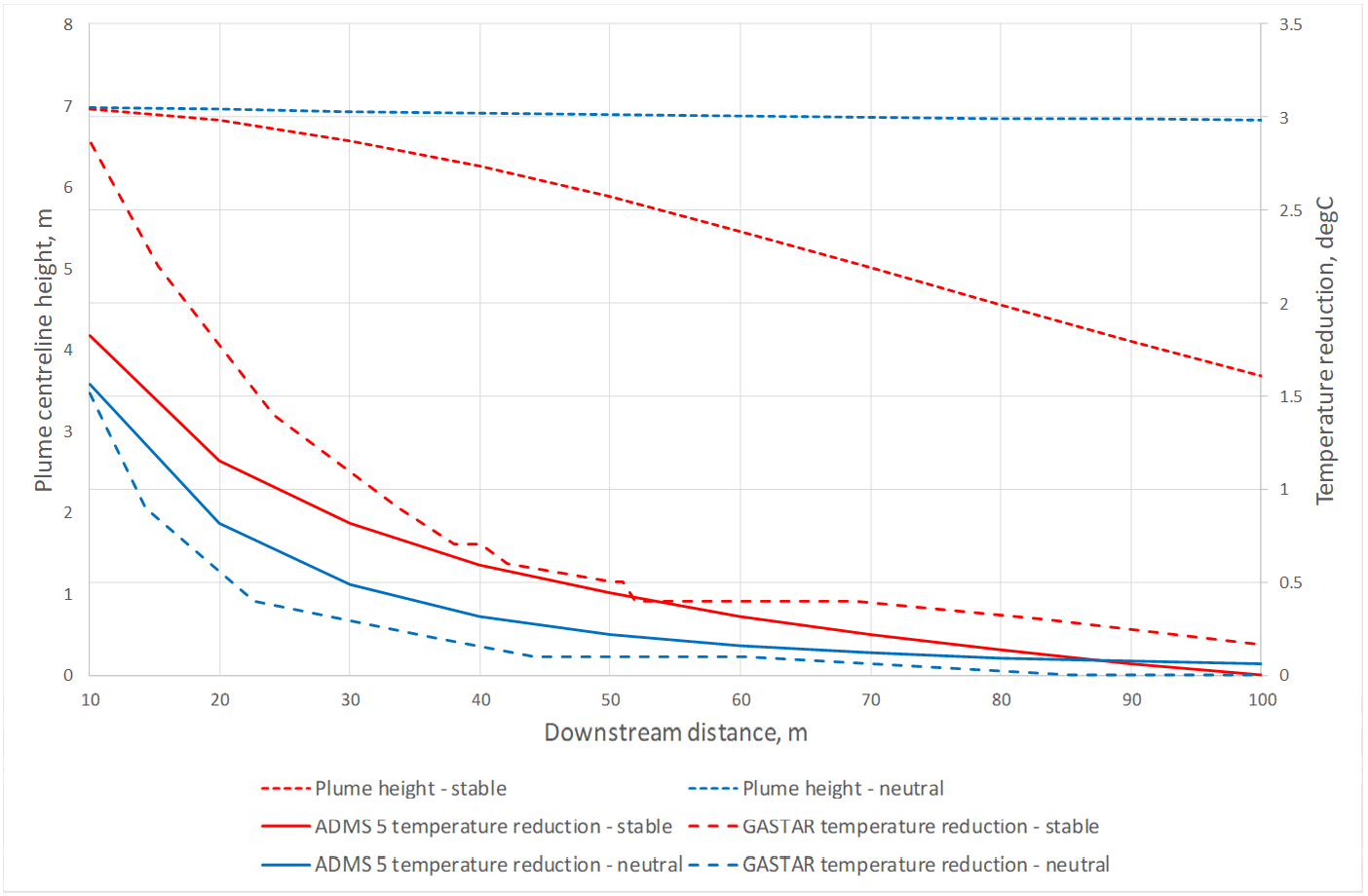
Plume centreline height and plume centreline temperature reduction
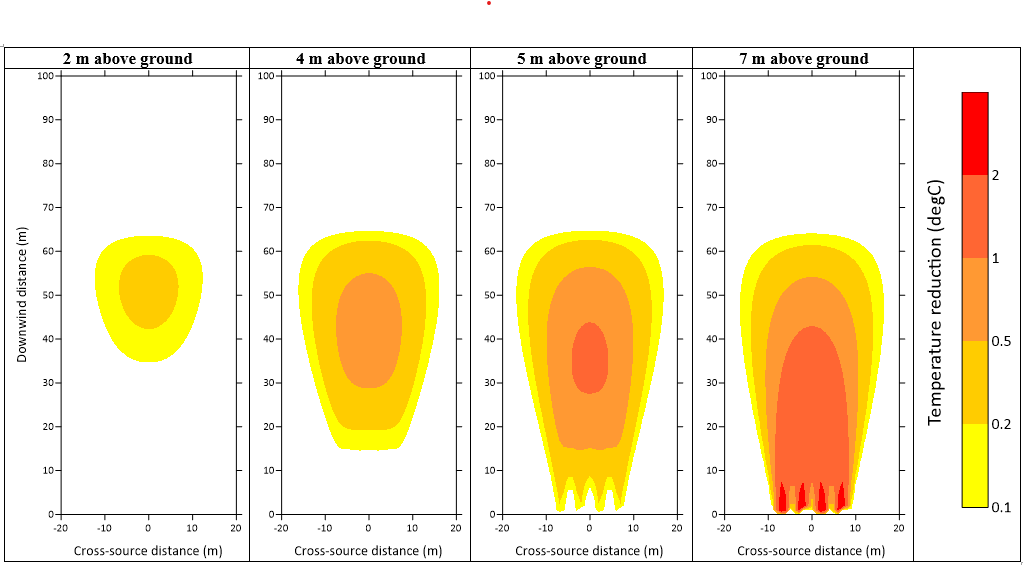
Temperature reduction at various heights above ground level, stable conditions
CERC was commissioned to carry out a novel assessment of the impact of plumes of cold air from an array of Air Source heat Pumps (ASHPs) on the surrounding air temperature.
In work commissioned by Sustainable Energy Ltd, CERC used ADMS and the dense gas dispersion model GASTAR to carry out dispersion modelling of the plumes of cold air. A single elevated jet, representing the emissions from a single ASHP unit, was represented in each model, and plume centreline height and temperature were output. The ADMS and GASTAR results agreed well; in both cases, temperature reductions decrease quickly with distance downstream.
ADMS was used to determine the meteorological conditions giving rise to the largest and smallest reduction in temperature due to the modelled jet. Stable conditions with low wind speeds gave the largest temperature reduction downstream of the release, and neutral conditions with high wind speeds gave the smallest temperature reduction; however, the difference in impact between these conditions was small.
For all meteorological conditions modelled, at receptors of various heights (trees, car park, offices and footpaths), the calculated temperature reduction was in the range 0-2 °C. Below a height of 5 m, the calculated temperature reduction was less than 1 °C.
